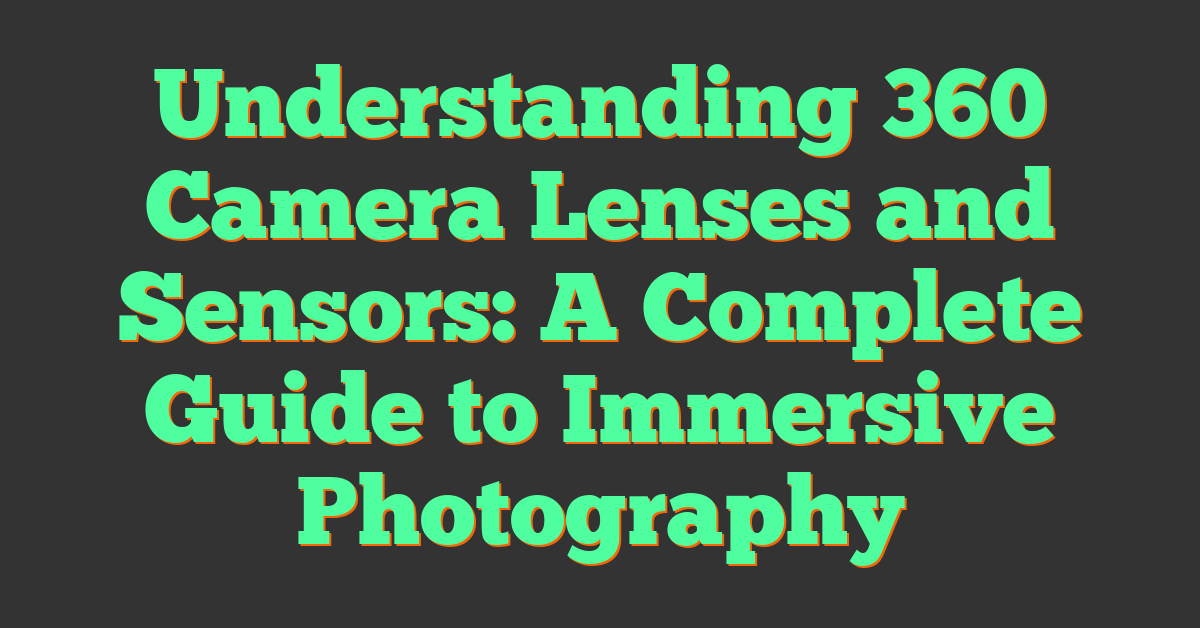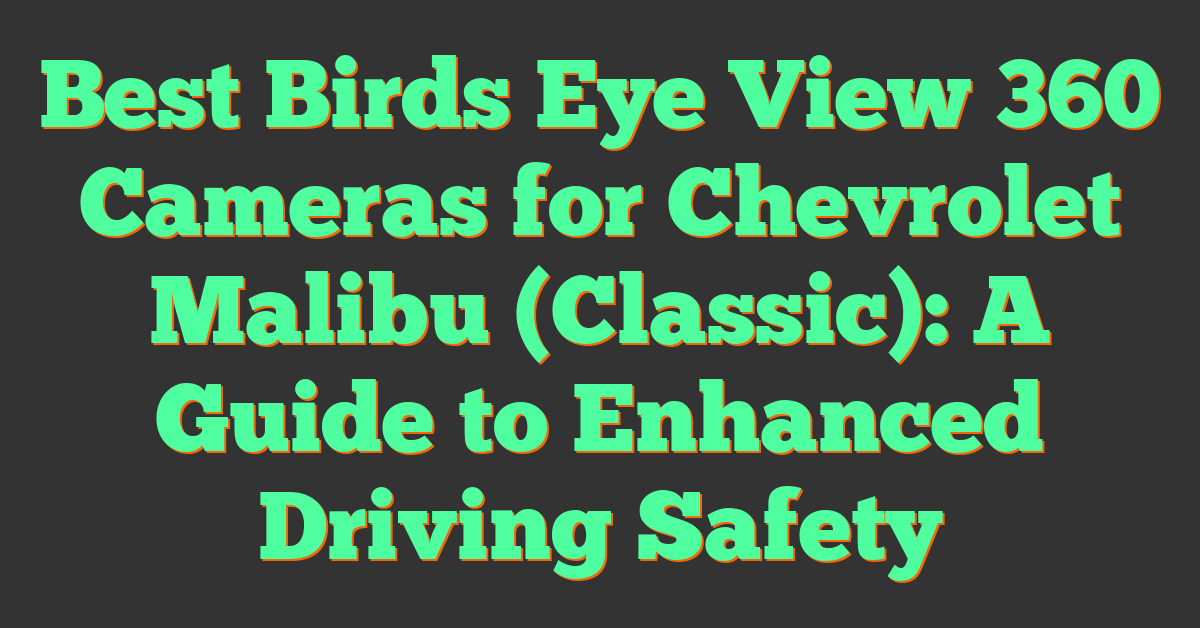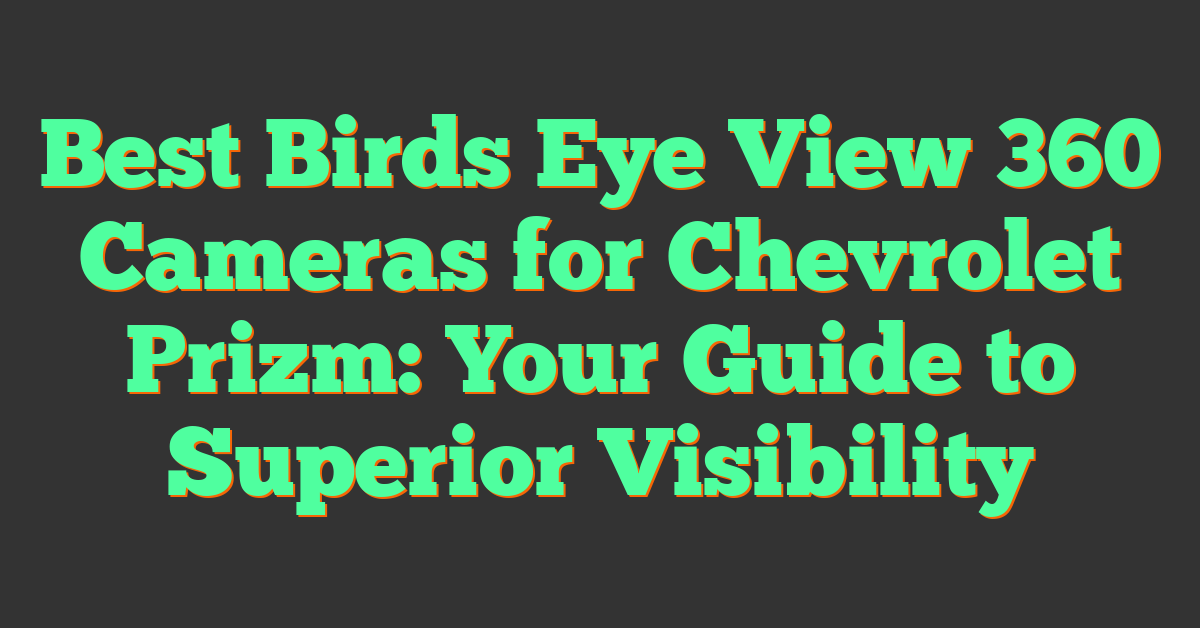Key Takeaways
- 360 camera lenses capture immersive, spherical visuals using fisheye or multi-lens designs, ensuring a full 360-degree field of view.
- Image sensors play a crucial role in determining image quality, low-light performance, and seamless stitching for vivid and detailed outputs.
- Larger sensors, like 1-inch CMOS types, offer superior clarity, dynamic range, and low-light capabilities compared to smaller sensors.
- Dual-lens systems are common in consumer 360 cameras, while professional setups use multi-lens arrays for higher resolution and VR production.
- Key considerations when choosing a 360 camera include lens quality, sensor specifications, resolution, portability, and stitching accuracy.
- Popular models, such as the Insta360 X3 and Ricoh Theta Z1, provide varying features like high-resolution capture, advanced stabilization, and excellent low-light performance.
Capturing the world in 360 degrees feels like stepping into the future of photography and videography. But behind those immersive images lies the magic of specialized lenses and sensors that make it all possible. If you’ve ever wondered how these cameras stitch together a seamless spherical view, you’re not alone.
Understanding the role of 360 camera lenses and sensors is key to unlocking their full potential. From fisheye lenses to dual-sensor setups, each component plays a critical part in creating those stunning visuals. Let me break it down for you so you can see how these technologies work together to transform how we capture and experience the world.
What Are 360 Camera Lenses?
360 camera lenses are specialized optics that capture immersive spherical images or videos, covering a full 360-degree field of view. These lenses are designed to work together with sensors to produce seamless visuals for virtual reality, panoramic photography, and interactive media projects.
Key Features Of 360 Camera Lenses
- Wide Field of View
360 camera lenses capture an ultra-wide field of view—often exceeding 180 degrees per lens. For example, fisheye lenses used in many 360 cameras can record nearly the entire hemisphere of their surroundings. Compact Design
These lenses are compact to fit into portable 360-degree cameras. This makes them ideal for travel and action photography, enhancing versatility for both professionals and hobbyists.
- Optical Distortion
Deliberate distortion, such as in fisheye designs, allows lenses to achieve their wide view. Software corrects this distortion during image stitching to create a smooth spherical image.
- Image Overlap for Stitching
Many 360-degree cameras use dual-lens setups, where each lens covers a significant portion of the same scene. This overlap ensures seamless stitching of the two halves into a single image or video.
Types Of 360 Camera Lenses
- Single-Lens Fisheye
Single-lens fisheye setups are common in consumer-level 360 cameras. They capture a wide view but often require software interpolation to fill gaps, making them less suited for high-resolution outputs.
- Dual-Lens Systems
Dual-lens systems use two fisheye lenses, each capturing 180-degree views. These lenses work together to generate complete 360-degree images. An example of this is found in popular cameras like the Insta360 ONE X2.
- Multi-Lens Arrays
Professional-grade 360 cameras use multiple lenses (e.g., six or more) to produce exceptional clarity and coverage. These cameras, like the GoPro MAX with its three-lens setup, are ideal for virtual reality production and commercial use.
- Stereoscopic 360 Lenses
« How 360 Cameras Enhance Social Media Content and Boost Engagement Like Never Before
360 Camera Basics for Non-Techies: Simple Tips to Capture Stunning Immersive Photos & Videos »
Stereoscopic lenses add depth by simulating two viewpoints, mimicking human sight. These are key for creating immersive VR experiences, as seen in VR-focused models like the Kandao Obsidian series.
How Do Sensors Impact 360 Cameras?
Sensors play a critical role in determining the performance and capabilities of 360 cameras. They influence image quality, low-light performance, and the seamless stitching necessary for immersive 360-degree visuals. Understanding how sensors function can help make informed decisions about choosing the right 360 camera.
Overview Of Camera Sensors
Camera sensors convert light into electrical signals to create digital images or videos. In a 360 camera, the sensor captures data from multiple lenses, ensuring all angles of a scene are covered. Modern sensors, such as CMOS and BSI (backside-illuminated) types, are favored because they deliver high-quality performance while being compact and energy-efficient. For example, 1/2-inch and 1-inch CMOS sensors are common in popular consumer-grade 360 cameras.
Sensor Size And Image Quality
Larger sensors generally produce better image quality due to greater light sensitivity and dynamic range. A 1-inch sensor, like the one in the Insta360 ONE RS 1-Inch 360 Edition, excels at capturing sharp, detailed shots with vibrant colors. Smaller sensors, on the other hand, may struggle with noise in challenging conditions. Sensor size directly affects resolution and the quality of stitched images, making it an important factor for both amateur and professional creators.
Low Light Performance In 360 Cameras
In low light, sensor sensitivity becomes vital for capturing usable photos or videos. High-performance sensors, combined with wide apertures, can minimize noise and retain detail even in dim environments. For instance, using an f/2.0 aperture paired with a 1-inch sensor provides excellent results when shooting cityscapes or interiors at night. Cameras like the Ricoh Theta Z1 stand out for their superior low-light imaging capabilities, optimized through advanced sensor technology.
Key Considerations For Choosing A 360 Camera
Determining the right 360 camera depends on several critical factors that affect image quality, usability, and functionality. I’ve outlined three areas to focus on that’ll guide photographers, videographers, and VR enthusiasts in their selection process.
Lens Quality
The lens is vital for capturing sharp, immersive 360 images and videos. High-quality lenses reduce distortion while maintaining clarity across the entire field of view. Dual-lens setups, like those in the Insta360 X3, are popular for stitching seamless 360-degree visuals. Multi-lens arrays, found in professional models like the Insta360 Pro 2, deliver higher resolutions and dynamic range. Fisheye lenses are essential for full-circle coverage, though their optical distortion should be corrected effectively using stitching software. Look for lenses with wider apertures (f/2.0 or lower) for better performance in low-light conditions.
Sensor Specifications
Sensor quality directly impacts the camera’s performance. Larger sensors, such as the 1-inch type in the Ricoh Theta Z1, improve image clarity, color accuracy, and low-light performance. CMOS and backside-illuminated (BSI) sensors are commonly preferred for their detail retention and lower noise levels. Resolution matters; cameras offering at least 5.7K video capture, like the Kandao QooCam 8K, ensure detailed footage. Also, pay attention to dynamic range for high-contrast scenes and low-light sensitivity, as these can make a noticeable difference in the overall output.
Compatibility And Use Cases
Choosing a camera suited to your workflow is essential. If portability or casual shooting is a priority, consider compact options like the Insta360 GO 2. For VR production or professional filmmaking, models supporting 8K or higher resolutions and advanced stitching algorithms, such as the Kandao Obsidian Pro, are suitable. Check app compatibility, file formats, and editing software integrations to ensure smooth post-production. For live streaming, cameras like the Insta360 ONE RS offer real-time stitching and broadcasting features, enhancing interactive content creation.
Pros And Cons Of 360 Camera Lenses And Sensors
Understanding the benefits and drawbacks of 360 camera lenses and sensors helps photographers and videographers make informed decisions. Drawing from my experience working in the 360 camera industry, here’s a detailed look at these aspects.
Advantages Of 360 Camera Technology
- Immersive Perspective
360 cameras capture a full spherical view, creating immersive content ideal for virtual reality and interactive experiences. This capability transforms traditional photography and videography by capturing everything in the scene. Compact And Portable
Most 360 cameras use lightweight and compact designs, making them easy to carry for travel and outdoor shoots. Devices like the Insta360 X3 balance portability with high performance.
- Improved Workflow
With advanced software, modern 360 cameras simplify post-production. Features like automatic stitching and stabilization help create seamless visuals without extensive editing.
- Multi-Purpose Use
These cameras work well for various applications, from professional filmmaking to real estate tours and action shots. Coupling dual-lens setups with quality sensors, devices like the GoPro MAX deliver versatility.
- Depth Addition For VR
Stereoscopic lenses enable depth perception to elevate virtual reality content, improving audience engagement.
Limitations To Be Aware Of
- Lower Resolution Per Frame
Even high-resolution 360 cameras distribute their resolution across a spherical image. This results in lower detail compared to a traditional camera covering the same subject.
- Light Sensitivity Challenges
Smaller sensors in compact 360 cameras often struggle in low-light conditions, producing noisy or less dynamic images. Larger-sensor models like Ricoh Theta Z1 address this but tend to be pricier.
- Distortion and Stitching Errors
While image stitching technology has improved, visible seams can occur if lenses or sensors aren’t perfectly aligned or when capturing subjects in motion.
- Expensive Professional Options
Advanced setups, such as multi-lens arrays used for cinematic quality, require significant investment. This can deter casual users or hobbyists.
- Post-Production Complexity
Despite advances in software, editing 360 content can still be complex compared to standard video or photography. Proper expertise and time are often necessary for achieving polished results.
Popular 360 Cameras On The Market
Capturing immersive 360-degree content starts with selecting the right camera. As someone passionate about 360 photography and videography, I stay updated on the latest models, features, and performance.
Comparison Of Top Models
Several 360 camera options stand out due to their performance, usability, and image quality. Below are a few popular choices.
- Insta360 X3: This camera offers dual 48 MP 1/2″ sensors that deliver sharp images and 5.7K video resolution. Its FlowState stabilization ensures smooth footage, even during movement. It’s ideal for both action shots and vlogging.
- GoPro Max: Known for its robust build and waterproof design, the GoPro Max is equipped with dual lenses and 5.6K video capture. It includes next-level stabilization (Max HyperSmooth) and the ability to live stream in 1080p.
- Ricoh Theta Z1: A favorite among professionals, this model boasts dual 1-inch sensors that excel in low-light conditions and produce stunning 23 MP stills. Its advanced stitching and 4K video capabilities make it perfect for high-quality outputs.
- Kandao QooCam 8K: The QooCam 8K features an impressive 8K video resolution and large 1/1.7” sensors. Its ability to capture fine details and handle dynamic scenes makes it a top choice for filmmakers.
Features To Look For
When choosing a 360 camera, focusing on specific features ensures a better match for your needs.
- Resolution: High resolution allows more detailed images and videos. Aim for at least 4K resolution for videos and 18+ MP for photos.
- Stabilization: Cameras with stabilization, like FlowState or HyperSmooth, deliver smoother footage. This is crucial for action shots or handheld use.
- Low-Light Performance: For photography or videography in dim environments, sensors like the 1-inch or 1/1.7” significantly improve performance.
- Stitching Accuracy: Poor stitching can leave noticeable seams. Opt for models with efficient in-camera stitching or easy-to-use editing software.
- Portability: Compact, lightweight designs foster ease of use. This is important for traveling or extended shoots.
- Live Streaming and Editing Compatibility: Cameras with live streaming functionality and compatible software simplify workflows for social media creators or professionals.
Conclusion
Understanding the intricate relationship between 360 camera lenses and sensors is key to unlocking the full potential of immersive photography and videography. These components work harmoniously to deliver the seamless spherical visuals that define 360-degree content, whether for casual use or professional projects.
By focusing on the right combination of lens quality, sensor performance, and camera features, you can make more informed decisions that align with your creative goals. As technology continues to advance, the possibilities for capturing and experiencing the world in 360 degrees are truly limitless.















